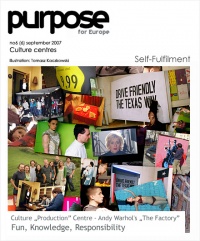
Feature
Palliative of art
I associate the notion ‘culture centre’ (although it may seem a too naïve association) with a place where artistic activity is supported and inspired – and I don’t mean financial aid only, but also ambitiously understood space for exchanging opinions, forms, ideas. Does anyone nowadays feel like establishing such idealistic associations? Of course, various artistic groups are set up with the aim loftier than simply encouraging and supporting each other in the world of market interrelations, ‘an art group’ however is not ‘a culture centre’. Unfortunately, a culture centre is a myth, is nothing but wishful thinking of an aesthete.
I must admit that I have happened to get some support from an institution which is registered as a ‘culture centre’. Several times I have picked a few hundred Euros from the Adam Mickiewicz Institute (I hope that didn’t make Adam Mickiewicz turn in his grave). That financial aid which I don’t despise being a postmodernist artists who is aware of the redemptive role of money – was related to the promotion of Polish culture outside our beautiful country. The money was duly transferred to my bank account – end of story.
To make it absolutely clear: I don’t dream of such a wonderful institution which, apart from offering me cash, will pat me on the back, ask what’s up and suggest an idea for a new song. Nothing like that. My only problem with ‘culture centres’ is of a semantic nature: why should one use such a high-flown notion in the context of money. I am absolutely in favour of various art patrons, but we should mind proportions. A septic tank mustn’t be called a perfumery, to quote a classic.
I shall risk an opinion that a ‘culture centre’ is a very outdated formation. Of course, there should be someone to distribute grants, award scholarships, organize exhibitions or announce competitions. But these are not centres on a par with say Parisian “Kultura” which was a value in itself. In our fragmented world the idea of a ‘culture centre’ has become terribly outdated. Artists don’t want to set up associations, although they willingly draw from various support programmes (which doesn’t surprise me at all). Of course, there are a few excellent media projects which are supposed to promote art (see: Nike Award), but calling those initiatives hatcheries of artists would be a real overstatement.
What could be called a contemporary ‘art centre’? The answer is simple: a hypermarket, the television, the internet. I am now reading the latest book by J.G. Ballard entitled “Kingdom Come” in which the problem of contemporary shopping centres is approached in a very interesting way. What are contemporary malls? How do they influence our perception, how do they shape our view of the world? If they are really the point of reference for contemporary man to define his identity, can’t we risk an opinion that it is these places that are our ‘culture centres’? Perhaps it is shopping which is the art of the 21st century?! If almost all areas of life are subordinated to the rhythm of shopping, going out to multiplexes, to bars or discotheques (and all those places are concentrated in one, ‘multimedia’ space of a mall), then what can be a better place to inspire artists than this dismembered centre of commerce, services and entertainment?

illustration: Tomasz Kaczkowski
Art has to draw from life, has to be the answer to the spirit of time. Even if it’s going on in the margin of an official rhythm of life, it has to be able to define, to call and interpret the mainstream. Whether we like it or not, we live in the world which does not have any clearly defined centre. We cannot speak about ‘culture and art centres’ because art went beyond its own limits long ago. In the world of permanent flows, blurring of borders, of re-interpreted ideas no space is left for the autonomy of culture and art. Semantic fluctuations became an element of art as such. There are no ‘centres’, there are permanent relocations within the Holly Trinity of the Present: Hypermarket, Television, Internet. Those are places where occasionally something that can be called an artistic achievement appears. It is these places that form our hyper-real horizon, whether we like it or not.
Check the archive

nr 36 September 2007
theme of the issue:
CULTURE CENTRES
< spis treści
Article
From the Editors
Interview
"new place for art" - interview with Aneta Dalbiak from Museum of Art in Łódź Promotion Department
Presentation
a-i-r
Kariera w kulturze
W różnorodności jest siła - interview with Grzegorz Lewandowski
Culture Industries
The 24 Hour Museum - conversation with Jane Finnis
Workshop
Fun, knowledge, responsibility - interview with Anna Michalak-Pawłowska, Dorożkarnia director
Feature
Palliative of art - Kuba Wandachowicz





